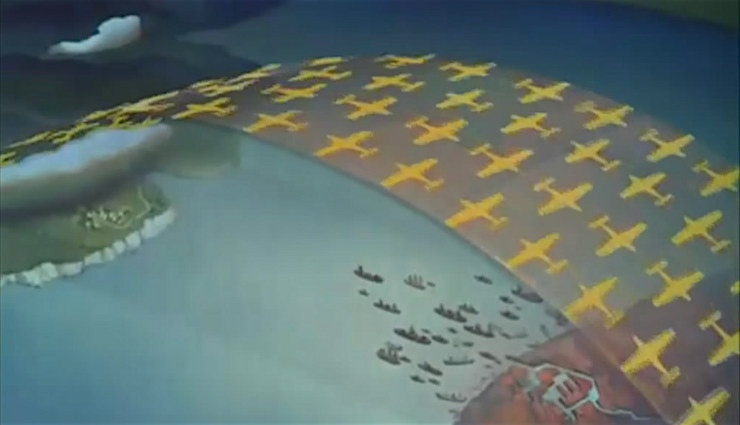As the United States entered World War II, Disney was in major financial trouble. A bitter strike had forced the company to raise salaries and make other financial concessions just when the company could least afford it. Three lavishly animated, expensive feature films—Pinocchio, Fantasia and Bambi—had flopped at the box office. The war had cut off access to most European movie theatres. The decision to make Bambi, based on a book banned by the Nazis, ensured that Disney would not have access to movie theatres in Nazi controlled areas for the foreseeable future. To make ends meet, the company started making training films for the U.S. military, making barely enough money to keep its doors open. The profits from Dumbo swiftly vanished.
In the midst of this financial crisis, Walt Disney read a book called Victory Through Air Power. He was immediately convinced that the author, Alexander P. de Seversky, had come up with a strategy for winning the war—an outcome that in 1942 did not look particularly certain. Disney had no money, and half of the Disney artists had either volunteered or been drafted into the war effort. Undaunted, Walt Disney took money that he didn’t have to create a colorful, animated version of the history of aviation and de Seversky’s strategy for winning the war, Victory Through Air Power—something he hoped would convince the public and Franklin D. Roosevelt that this strategy was the key to victory. He even invited de Seversky to participate in the film, and dedicated the film to General Billy Mitchell and U.S. airmen.
Incidentally, since the idea for making the film came from a book, and the book’s author actually appears in the film, yes, this film should have been covered in the Read-Watch portion. It wasn’t, mostly because the film is usually not listed in the standard Disney canon, partly because I didn’t have access to a clean copy at the time, and partly because this is not exactly Disney reinterpreting/adapting a book: it’s Disney giving an author a platform for his argument, to the point of having him speak and explain his ideas in the film and wave a pointer at maps. And partly because Victory Through Air Power is, unlike almost all of the other films in the Read-Watch, a mix of animation and live action—but where the animation and live action are not intended to interact with each other. Rather, the animation is intended to explain the live action.
For once, the live action portions proved far more difficult to film than the animated ones, with the narration giving the film directors particular fits. Disney’s soundstage was located near Lockheed Martin, then undergoing regular flights and flight tests thanks to the wartime conditions, and was not soundproof. De Seversky and narrator Art Baker (then primarily known for his radio show) ended up having to film and record at night, in between airplane sounds. De Seversky had also never been filmed before, and had difficulty working with the camera and his lines; he did not walk well, thanks to an amputated leg.
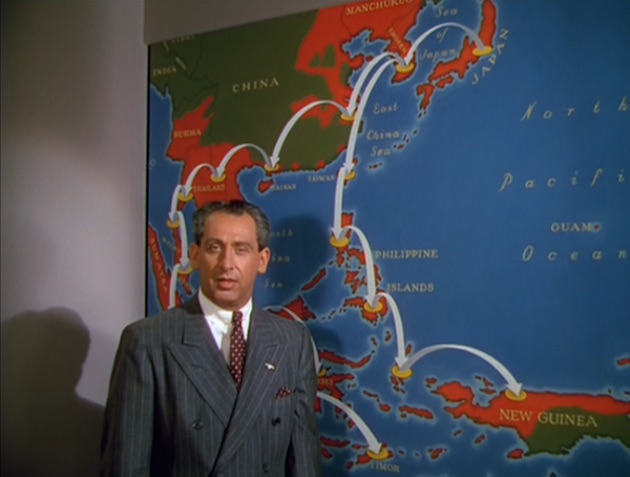
Not that the animated portions of the film were entirely easy, either. The film’s subject matter, especially in the second half, forced Disney artists to abandon loose, cartoonish, round drawings for realistic drawings of very real planes and bombs—if occasionally alleviated by cartoonish moments of arrows and fire falling down on British flags. If nothing else, this demonstrated that training artists to create realistic, detailed animation for Fantasia’s Rite of Spring sequence and Bambi had not been a completely wasted effort. Artists were also forced, as they had been for parts of Fantasia, to animate something they had never animated before—in this case, flying airplanes, bombs, and explosives. And they had to do so on a much more limited budget, and without full use of the multiplane camera. In fourteen months. Walt Disney wanted this picture out quickly.
Animators found three solutions. First, they kept the backgrounds as simple as possible—single colored, if necessary—a technique that had worked to save money on some frames in Dumbo. During a moment showing planes flying over London, for instance, the only visible building is Big Ben—just enough to let audiences think oooh, London, without forcing the artists to draw and paint the full London skyline. In a few cases, animators avoided illustrating anything at all, instead creating simplified maps, which the camera lingered on for a few seconds before a small animation of an explosion or an arrow was added. In some frames, nothing was animated at all. Instead, a camera simply panned across the illustration. The most chilling example of this probably occurs near the end, when, lacking the money to create realistic animations of human pilots, Disney artists simply drew an illustration of pilots sitting and half smiling in a cockpit, letting the camera pan across the image, giving a near illusion of movement before they bomb Japan and set it on fire.
In other scenes, Disney artists simply drew fewer frames per second of film, something generally termed limited animation, a technique later associated with cheap children’s cartoons of the 1970s and 1980s. Though apart from the explosions, almost nothing can be further from Voltron and Thundercats than Victory Through Air Power.
The first part of the film—originally planned for another project—tells the early history of aviation in cartoon form. This portion has, to be kind, some bumps, for instance, when it tries to convince us that after World War I, the airplane was still regarded as nothing but a novelty that had to struggle to justify its existence, right before launching into the history of transatlantic and around the world flights, not to mention the development of Air Mail (kiddies, this was a Big Thing in those dark, nearly forgotten days before the internet) and airlines. Which is to say, the film ends up immediately countering its own narrative: after World War I, the airplane was never considered a novelty. At other points, the film chooses its words very carefully. When it announces, for example, that the airplane “was the only weapon of war to develop such great usefulness in peacetime,” which (a) how quickly we all forget the development of the stirrup, and (b) also neatly jumps right past a slightly less child friendly development from World War I: Kotex’s new line of disposable sanitary napkins, designed to make use of leftover fiber from bandages.

Also, industrial fertilizer, which, unlike the airplane, really was originally developed as a weapon of war in World War I.
If apparently completely ignorant of the history of industrial fertilizer, this section does have its amusing moments. I particularly like the bumpy flight across the United States by Calbraith Perry Rogers, punctuated by frequent crashes. It shouldn’t be funny, given that Rogers died shortly after making his transcontinental journey, but it is. I also like the rather random but cute little peace dove that flies in to represent 1919. The film also has some interesting stuff about creating a machine gun that can shoot through propellers without shooting off the propellers, and throwing bricks and grenades at your fellow pilots, if you like that sort of thing, and ramps up when it reaches World War II, telling us in an exultant voice about just how big bombs are in 1942:
“Today, WE’RE STARTING WITH TEN TON BOMB LOADS! OF THE MOST DEVASTATING EXPLOSIVES EVER CONCEIVED BY SCIENCE!”
Not all that far away, scientists with the Manhattan Project were conceiving of something worse. The film continues, using a British accent to quote a British aviator:
“Departing from England, the flight across the Channel was quite uneventful. Reaching the other side, and being recognized, dropped greetings [sound of machine gun fire], and without stopping [sound of bombs falling to the ground], returned home safely, without a mishap.”
On screen, France blows up. The narrator excitedly tells us that the bomb load dropped on Cologne in one night was twenty times greater than the total amount used in the last war by the United States.
It’s a rather jarring tonal shift, especially coming just ten minutes from the silly, cartoonish history of the Wright Brothers.
After another exultant comment about just how many things 1942 planes can blow up, the film turns to Alexander P. de Seversky, a man who, the film assures us, began his military training in Russia at the age of 10, and when not attending military school, focused on planes. He was shot down during World War I (depicted in a cartoon), and, after the Communist Revolution (a name not mentioned in a film that very much wanted its viewers to think of a Stalin as an ally, not a Communist), fled to the United States and began working in military aviation.
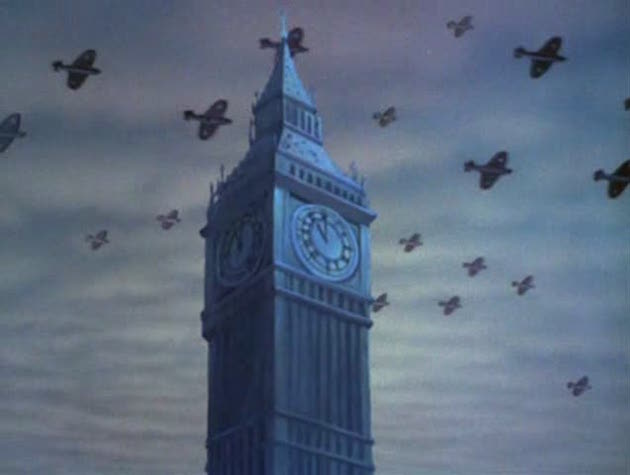
De Seversky begins by warning viewers that thanks to aviation, the distinction between soldiers and civilians have been erased, since airplanes do not need to be confined to a battlefield. He added that he believed it was only a matter of time before the U.S. began to suffer civilian casualties. Planes, he noted, could carry a war directly over a country’s army and navy, striking directly at a country’s source of power—and its civilians. De Seversky had the Battle of London and the battles between Germany and the Soviet Union in mind, not 9/11, but the argument remains relevant today.
At this point, the film returns to animation, but a very different sort of animation, unlike anything Disney had done before—or would do again: realistically drawn scenes of aerial warfare and bombing combined with cartoon maps, occasional moments of proclaiming DUNKIRK in big flamboyant letters across the screen, huge smoke clouds and fires, and pilots falling to their death, in a step by step history of the early years of World War II with a sharp focus on air power and an almost hysterical insistence that air power was always, always the deciding factor—except during the moments when de Seversky and Disney wanted audiences to panic about German U-Boats instead. Almost all of this is narrated in either an excitable Russian voice (de Seversky) or an only slightly calmer American voice simmering with barely repressed excitement (Art Baker), regularly interrupted to allow de Seversky to explain his military strategy.
A few cartoonish moments remain here and there—a visual joke of military supplies moving through a bottle to represent a bottleneck, for instance, or a rather terrifying image of Japan and its puppet kingdom Manchukho transforming from two countries on a map into a monster that starts to chomp down on Siberia. Or the moment depicting the large, fat arrows of U.S. forces futilely striking at an expanding and shrinking and seemingly unbreakable Nazi wheel, marked with a huge swastika. But most of the animation remains strikingly realistic and focused on bombs, with images showing planes bombarding each other, countries exploding, and a bomb dropped in a reservoir just behind a Japanese dam exploding it, as the narrator says triumphantly, like an egg shell, and flooding everything.
It all ends with a very angry American Eagle beating up a black octopus—representing Japan—before heading off to CONQUER THE WORLD and then turn into the top of a flag pole waving a U.S. flag.
I felt kinda sorry for the octopus.
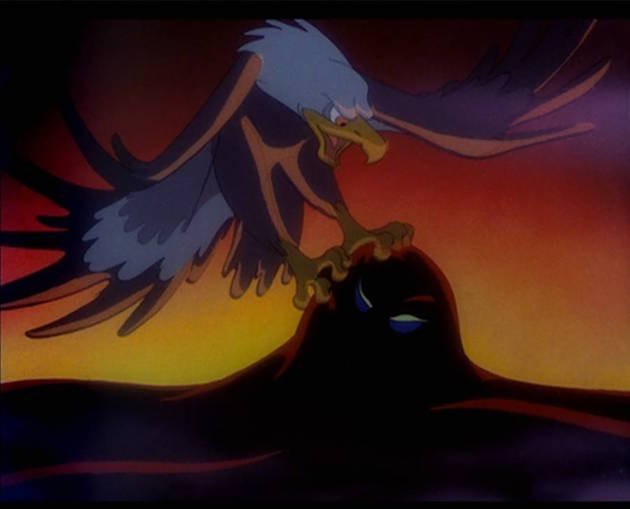
The film is unrelenting, visually and verbally, in its message: the only way for the United States to defeat Germany and Japan is through air power, which, fortunately, the United States is completely capable of doing, so, victory will come. It’s both argument for creating long range airplanes capable of dropping huge bombs on Japanese dams, and comforting reassurance that yes, even though planes can and will kill civilians at any moment, the United States has the resources and ability to win.
It’s not remotely subtle, or intended to be, and not always convincing. I left the film thoroughly convinced that invading China through Burma (now Myanmar) is an impractical idea, but also left relatively convinced that the U.S. was still going to need to conduct quite a bit of this war on the ground and, in the Pacific, by sea, and that it is not nearly as easy to attack Japan from airbases in the Aleutian Islands as this film assures me it would be.
I have, of course, the benefit of hindsight, and of knowing that history has proven that de Seversky’s hypothesis was wrong, and that MacArthur’s strategy of island hopping—scoffed at by de Seversky—did eventually lead to a U.S. victory in Pacific. I also have the benefit of knowing that the European conflict was eventually won through a combination of military forces from multiple countries, and that, while this film was being made, scientists were working on the Manhattan Project. And the benefit of easy access to instant information about the Aleutian Islands, which suggests that using them as a basis for an airstrike against Japan is not as easy as this film attempts to suggest.
And as someone far removed from the combat situation, it’s easy for me to note the flaws in an argument that simultaneously wants me to believe both that air power is superior to any other military technology and that incapable of flying U-Boats, were the greatest threat faced by the United States.
Yet, despite the subject matter, and the argumentative problems, several frames of this—the British planes flying behind Big Ben, an exploding battle ship, planes flying away into the clouds after blowing stuff up, crippled boats sunk in the sea, are starkly beautiful, odd though it may seem to use that term to discuss animated images of warfare. But even on a limited budget Disney animators could not quite lose their artistry.
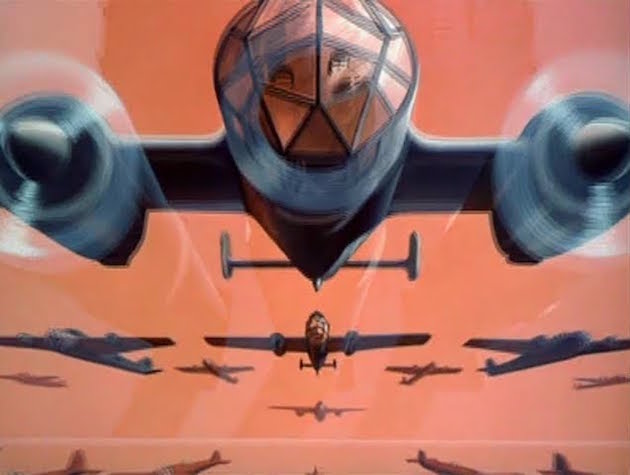
That artistry was not enough to convince RKO Studios to distribute the film. It was instead distributed by United Artists, to less than universal acclaim. Not just because it was, to put it mildly, an atypical Disney film, but because of the propaganda—described kindly by The New York Times as “encouraging and inspiring propaganda,” but, still, propaganda. Parents whose children were still recovering from Bambi did not rush to see a film focused on how to best kill massive numbers of people. The film barely made back its production budget, but once distribution and marketing costs were included, it was another financial loss for the studio, and the one Disney film that could not be converted into some sort of merchandising opportunity or theme park attraction.
One viewer, however, was enthusiastic: Winston Churchill. The British prime minister was so enthusiastic, he insisted on having a print sent to Franklin Roosevelt. Walt Disney allegedly later told one of the film’s directors, H. C. Potter, that FDR decided to support bombing missions in Europe after seeing the film.
With the film’s purpose achieved, Disney sent Victory Through Air Power straight to its vaults, where, with the exception of the early history of aviation scenes, it stayed until 2004 when Disney briefly released it on DVD as part of the Walt Disney Treasures DVD series, before promptly sending it back to the Disney vaults again. It remains difficult to get a hold of even now, although various bootleg copies and some terrible YouTube transfers exist.
Which is a pity. This is definitely not one of the Disney greats, nor does it fit with the rest of the Disney brand, not even in the uneasy way that Fantasia stands apart from the rest of the Disney films. It’s also, bluntly, not always all that entertaining to watch. Even the parts that are more entertaining—that cartoon history of aviation and air power, for instance—have moments that are disturbing, most notably the decision to use caricatures and silly cartoons to depict World War I aviators killing each other. The film’s choice to more or less completely ignore the existence of the Soviet Union, if somewhat understandable given that its chief advocate had previously fled Russia, feels, well, odd. Many portions of the film are offensive to Japanese and Southeast Asians.
But for history buffs and Disney completists, it’s a fascinating piece, a look at how Disney thought the war could be fought, and the images it designed to assure U.S. citizens that yes, the United States could win.
Next up, something far more typical of the Disney oeuvre: Lady and the Tramp.
Mari Ness lives in central Florida.










